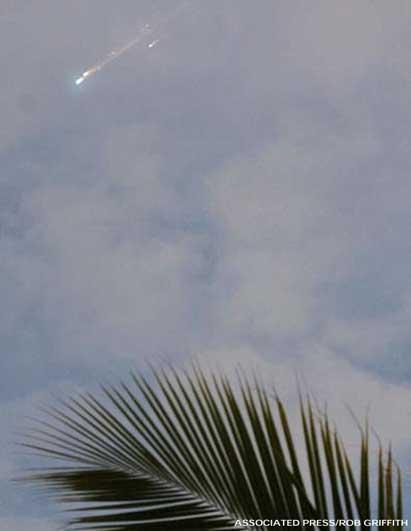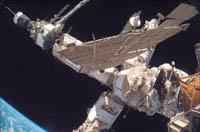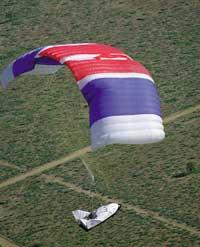Agur ós y honor, Mir
2001/03/22 Carton Virto, Eider - Elhuyar Zientzia | Imaz Amiano, Eneko - Elhuyar Zientziaren Komunikazioa | Urresti, Igor - Elhuyar Zientziaren Komunikazioa
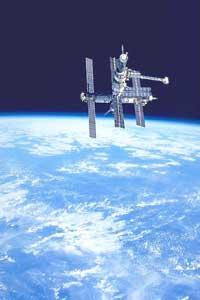
The road to the Soviet permanent space station began in 1964, three and a half years after the launch of the first cosmonaut Juri Gagarin, when General Txelomei decided to build in the company OKB-52 the first orbital space station formed by his co-workers. The station designed for this era was giant: 20 tons of weight and 4.1 m of diameter. Nor was the random diameter chosen, since it was the largest size that could transport the train to the Baiconur shooting station.
The objective was to build a permanent space of work in orbit around the Earth, where to carry out scientific and military tests. The program was baptized as Soiuz (unity) and started in 1967, when the ship Soiuz 1 was put into orbit. Although the first missions had serious problems (first person dead in space, Vladimir Komarov, 1967), the Soviets gradually developed the technology necessary to work in space. The Gemini program, which the Americans had in progress at that time, was also in tough competition. Finally, in 1970, in the mission Soiuz 9, the cosmonauts remained 18 days in space and managed to overcome the record of permanence of 14 days in the five years that lasted Gemini 7. In 1973 the Americans again tried to develop the permanent space stations, but the Skylab program failed and decided to reinforce especially the road of ferries, the development of ships more than one trip.
However, the Soviets followed the Saliut program: Saliut 7 broke all the records of permanence until then, since the cosmonauts remained there for eight months. Finally, on February 19, 1986, the Soviets put the Mir space station in orbit. And the station designed for four or five years has been working for 15 years!
We will only say the structure and the contributions it has made, since for this you only have to see the February issue of the magazine Elhuyar Zientzia eta Teknika.
"Landing"
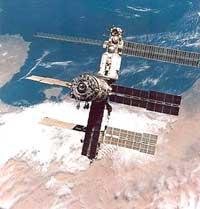
The Landing Mir is not a simultaneous work. It is not the first device to come back from space, but the largest, especially if we compare it to the Progress M1-5 that has been stuck to make a controlled return. Although 20 times lighter than Progress Mir, it is the Russian station that in recent times will guide and lead to the fall zone.
The usual orbit of Mir is about 248 km from Earth. Leaving the station on his own, he slowly approaches the Earth and finally enters the atmosphere and precipitates. This would mean an uncontrolled fall, and a fall anywhere. For this reason, to avoid or reduce as much as possible the risks, one must “collaborate” in driving. Starting from the initial orbit, it has lost an altitude of 1.8 km a day. It has already exceeded 220 km and there is no turning back. In the coming hours they will activate the altitude control system of the ship Progress M1-5 that has Mir and will place the station in the appropriate position and orientation for its "landing".
Three times the Progress M1-5 engines will be switched on. In the first one will light up for 51 minutes and will give an impulse of 8.96 m/s to Mir. In the second one a lower orbit will be lit for 23 minutes and will be driven to 10.08 m/s. Finally, two orbits below start the engines for 22 minutes and give a 25 m/s push. The first two will use the fuel of the Progress M1-5 and the third will use the fuel of both. As a result of these impulses, they will be at an altitude of 82 km and only from there will they collapse to the Barbaric Sea between 47º S and 140º W (1,500-2,000 km southwest of Australia). When entering the atmosphere will burn most of its 137 tons. However, the approximate section of 35 tons will fall in the aforementioned zone, but small fragments of up to 20 tons will also occur that will lead to an area between 3,000 and 4,000 kilometers in length and 200 kilometers in width.
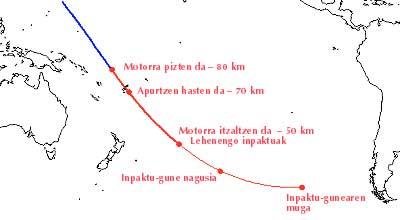
Why in the Pacific?
The first reason to take into account is the need for a large unpopulated area, a condition that is met in the southern part of the Pacific. But in addition, the Mir station has an orbital inclination of 52 degrees, which means that the station usually passes daily on Earth between 52ºN and 52ºS. Finally, it is recommended that the impact area be placed at 180° of the final thrust of the engines, in order to be able to run it passing the thrust station through the area controlled by the Russians. All these conditions are met in the south of the Pacific and have therefore been chosen.
The choice of place has been more complicated than the choice of place. First, the Russians have very little fuel and little power to carry out the landing, so they had to choose very well the control sequence of the Progress M1-5. If the operations started with Mir too high, the fall zone could be left behind and the station could fall in Europe. Even if it started too late, it would fall anywhere else. The drills took the limit to an initial altitude of 250 km, but then left the limit in the 220 km it has exceeded this morning.
However, the Russians have more than one chance to bring to fruition the fall of Mir. Mir turns to Earth every 90 minutes and, as the angle of Earth changes, does not cross the same area in each orbit. However, in the south of the Pacific Ocean there is a point of convergence (see figure below) that crosses this area four times in a row, so that the Russians have four orbits to carry to a good end the sequence of fall.
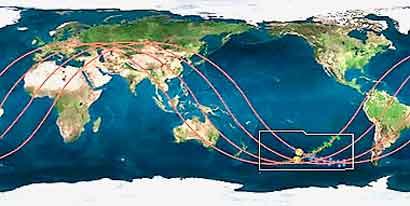
Just as it happens with almost everything the Russians do, these have been days of rumors, mistrust and picaresque around Mir, but it does not seem that tomorrow there are surprises in the morning. At seven will sink into the Mir sea forever. Dear.

Gai honi buruzko eduki gehiago
Elhuyarrek garatutako teknologia




